Navigation
Research Support Facility Becomes A Model of Super Energy Efficiency
The Research Support Facility (RSF), the US National Renewable Energy Laboratory's newest sustainable green building is a model for energy efficiency and renewable energy technologies.
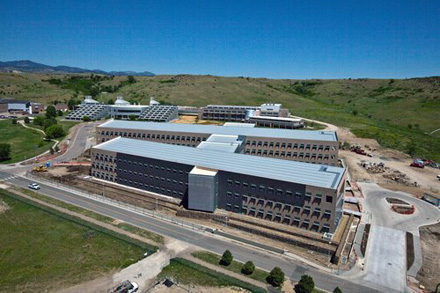 |
| The Research Support Facility (RSF) is NREL's newest sustainable green building and was completed in June 2010. |
The Research Support Facility (RSF), the US National Renewable Energy Laboratory's newest sustainable green building is a model for energy efficiency and renewable energy technologies.
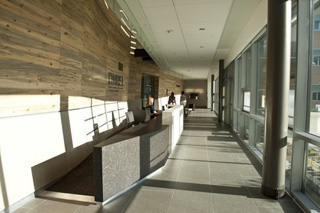 |
| The RSF is designed to provide maximum daylighting throughout the building. Photograph by Dennis Schroeder |
Owned by the U.S. Department of Energy (DOE), the RSF incorporates several innovative design features and renewable energy strategies developed at the National Renewable Energy Laboratory (NREL). The 222,000 sq. ft., LEED™ platinum office building is occupied by about 800 NREL and DOE employees.
The energy goal for the building is 32kBtu/ft2/year. A rooftop photovoltaic system is to be implemented through a Power Purchase Agreement; daylighting; natural ventilation; and a next-generation, energy efficient data center are just a few of the energy features of the building.
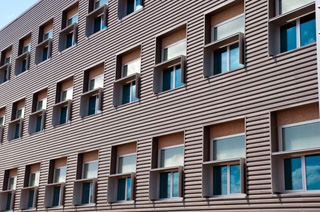 |
| Much of the south-facing wall at the RSF employs passive heating technology developed at NREL. Highly efficient, these collectors can capture up to 80 percent of the energy of the sunlight striking the collector. Outside ventilation air is passively preheated via transpired solar collectors (a technology developed by NREL) on the RSF building's south face. By using a dark-colored, perforated metal plate on the south side of a building, three NREL scientists have perfected a way for buildings to pre-heat the air coming in, reducing the need for additional heating energy. The basic concept of a transpired solar air collector is for the perforated plate to be warmed by the sunlight hitting the south side of a building. A fan added to the building's existing ventilation system slowly draws warmed ventilation air into the building through the plate. The solar energy absorbed by the dark plate is transferred to the air flowing through it. This process can efficiently preheat the air going into a building like the RSF by as much as 40 degrees F. Photograph by Pat Corkery |
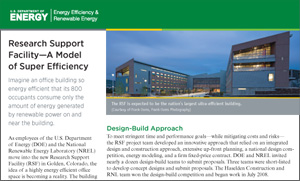 |
A new fact sheet, Research Support Facility—A Model of Super Efficiency (PDF 461 KB), provides more information about the design-build approach, high-performance design features, materials, the workplace of the future, and a cost comparison summary.
The RSF design and construction experience is being chronicled and will be shared widely to promote the production of high-performance building designs at competitive costs.
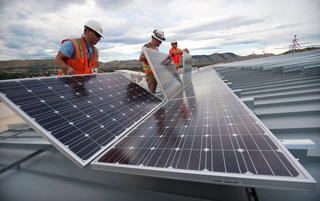 |
| Roof-mounted solar panels are going to help provide power to the RSF, reducing the lab's carbon footprint. Photograph by Dennis Schroeder |
Building Description
The RSF building was designed for about 800 staff from NREL and the Department of Energy. This new flagship building:
- Incorporates the concepts of safe design into the planning, design, construction, and operation of the facility
- Meets the Platinum certification as defined by the US Green Buildings Council Leadership in Energy and Environmental Design (LEED™) Green Building Rating System
- Meets the requirements of the workforce of today and tomorrow
- Provides the lowest attainable energy use per square foot
- Provides an architectural image that is consistent with the site and NREL's identity.
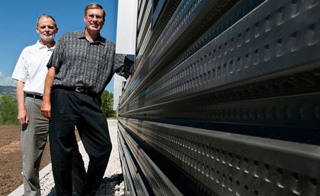 |
| Outside ventilation air is passively preheated via NREL's transpired solar collector on the building's south-facing wall before delivery to the labyrinth and occupied space. From left: NREL's Craig Christensen and Chuck Kutscher. Photograph by Dennis Schroeder |
Construction
Read how the building was constructed to be highly energy-efficient and sustainable:
- NREL Solar Technology Will Warm Air at 'Home'
- New Low-Energy Building a Landscape Leader, Too
- Sustainable Solutions Abundant in New Offices
- Green Computing Helps in Zero Energy Equation
- Light Inspires Energy Efficient Building Design
- NREL Sets the Bar for Office Building Energy Use
- Building Panels Protect, Provide Comfort
- Recycled Natural Gas Pipes Shore Up Green Building
- Labyrinth to Store Energy in Basement for Later Use
Getting to Net Zero Energy Through a Performance-Based Design/Build Process
Jeff Baker from the U.S. Department of Energy (DOE), Phil Macey from Haselden Construction, and Bill Glover from NREL discuss how the RSF and net-zero energy buildings are achievable and marketable now in this DOE Building Technologies Program Webinar.
- View the presentation slides (PDF 5 MB).
- View the recorded Webinar (WMV 14.2 MB). You can also read a text version of the audio.
Design-Build Contract
A design-build contract of approximately $64 million was awarded for the RSF, and the design-build team includes Haselden Construction and RNL. The benefits of the design-build process are:
- One contractor performs architecture/engineering and construction to improve project efficiency, cost, scope, and schedule performance
- The competitive market provides the most technically-sound and cost-effective solution based on well-defined user performance standards
- Project delivery and execution improves.
RSF Prototype at Golden Hill
NREL's Information Services (IS) staff prototyped the new workstations and technologies planned for the RSF. This helped ensure that employees moving into the RSF would know all about the "workplace of the future."
Nearly 100 employees prototyped several new workstation configurations that utilized shorter cube heights and allowed for maximum daylighting and lower energy costs. Along with the furniture, IS tested many of the new information technologies now in the RSF. Learn how NREL tested the energy-saving office of the future.
Note:
NREL of the U.S. Department of Energy, Office of Energy Efficiency and Renewable Energy is operated by the Alliance for Sustainable Energy, LLC.
This news is from NREL.
NREL Research Support Facility
The ideas and innovations that define NREL are now shaping the next generation of commercial office buildings. DOE's Research Support Facility at NREL, will set a new benchmark for affordable, sustainable commercial design and construction. The unique form of the RSF is driven by energy-saving strategies, many researched and advanced at NREL.
Search
Latest articles
Agriculture
- World Water Week: Healthy ecosystems essential to human health: from coronavirus to malnutrition Online session Wednesday 24 August 17:00-18:20
- World Water Week: Healthy ecosystems essential to human health: from coronavirus to malnutrition Online session Wednesday 24 August 17:00-18:20
Air Pollution
- "Water and Sanitation-Related Diseases and the Changing Environment: Challenges, Interventions, and Preventive Measures" Volume 2 Is Now Available
- Global Innovation Exchange Co-Created by Horizon International, USAID, Bill and Melinda Gates Foundation and Others
Biodiversity
- It is time for international mobilization against climate change
- World Water Week: Healthy ecosystems essential to human health: from coronavirus to malnutrition Online session Wednesday 24 August 17:00-18:20
Desertification
- World Water Week: Healthy ecosystems essential to human health: from coronavirus to malnutrition Online session Wednesday 24 August 17:00-18:20
- UN Food Systems Summit Receives Over 1,200 Ideas to Help Meet Sustainable Development Goals
Endangered Species
- Mangrove Action Project Collaborates to Restore and Preserve Mangrove Ecosystems
- Coral Research in Palau offers a “Glimmer of Hope”
Energy
- Global Innovation Exchange Co-Created by Horizon International, USAID, Bill and Melinda Gates Foundation and Others
- Wildlife Preservation in Southeast Nova Scotia
Exhibits
- Global Innovation Exchange Co-Created by Horizon International, USAID, Bill and Melinda Gates Foundation and Others
- Coral Reefs
Forests
- NASA Satellites Reveal Major Shifts in Global Freshwater Updated June 2020
- Global Innovation Exchange Co-Created by Horizon International, USAID, Bill and Melinda Gates Foundation and Others
Global Climate Change
- It is time for international mobilization against climate change
- It is time for international mobilization against climate change
Global Health
- World Water Week: Healthy ecosystems essential to human health: from coronavirus to malnutrition Online session Wednesday 24 August 17:00-18:20
- More than 400 schoolgirls, family and teachers rescued from Afghanistan by small coalition
Industry
- "Water and Sanitation-Related Diseases and the Changing Environment: Challenges, Interventions, and Preventive Measures" Volume 2 Is Now Available
- Global Innovation Exchange Co-Created by Horizon International, USAID, Bill and Melinda Gates Foundation and Others
Natural Disaster Relief
- STOP ATTACKS ON HEALTH CARE IN UKRAINE
- Global Innovation Exchange Co-Created by Horizon International, USAID, Bill and Melinda Gates Foundation and Others
News and Special Reports
- World Water Week: Healthy ecosystems essential to human health: from coronavirus to malnutrition Online session Wednesday 24 August 17:00-18:20
- STOP ATTACKS ON HEALTH CARE IN UKRAINE
Oceans, Coral Reefs
- World Water Week: Healthy ecosystems essential to human health: from coronavirus to malnutrition Online session Wednesday 24 August 17:00-18:20
- Mangrove Action Project Collaborates to Restore and Preserve Mangrove Ecosystems
Pollution
- Zakaria Ouedraogo of Burkina Faso Produces Film “Nzoue Fiyen: Water Not Drinkable”
- "Water and Sanitation-Related Diseases and the Changing Environment: Challenges, Interventions, and Preventive Measures" Volume 2 Is Now Available
Population
- "Water and Sanitation-Related Diseases and the Changing Environment: Challenges, Interventions, and Preventive Measures" Volume 2 Is Now Available
- "Water and Sanitation-Related Diseases and the Changing Environment: Challenges, Interventions, and Preventive Measures" Volume 2 Is Now Available
Public Health
- Honouring the visionary behind India’s sanitation revolution
- Honouring the visionary behind India’s sanitation revolution
Rivers
- World Water Week: Healthy ecosystems essential to human health: from coronavirus to malnutrition Online session Wednesday 24 August 17:00-18:20
- Mangrove Action Project Collaborates to Restore and Preserve Mangrove Ecosystems
Sanitation
- Honouring the visionary behind India’s sanitation revolution
- Honouring the visionary behind India’s sanitation revolution
Toxic Chemicals
- "Water and Sanitation-Related Diseases and the Changing Environment: Challenges, Interventions, and Preventive Measures" Volume 2 Is Now Available
- Actions to Prevent Polluted Drinking Water in the United States
Transportation
- "Water and Sanitation-Related Diseases and the Changing Environment: Challenges, Interventions, and Preventive Measures" Volume 2 Is Now Available
- Urbanization Provides Opportunities for Transition to a Green Economy, Says New Report
Waste Management
- Honouring the visionary behind India’s sanitation revolution
- Honouring the visionary behind India’s sanitation revolution
Water
- Honouring the visionary behind India’s sanitation revolution
- Honouring the visionary behind India’s sanitation revolution
Water and Sanitation
- Honouring the visionary behind India’s sanitation revolution
- Honouring the visionary behind India’s sanitation revolution

